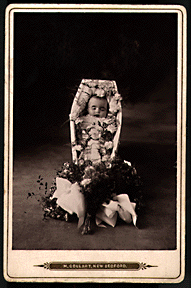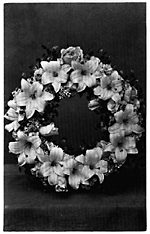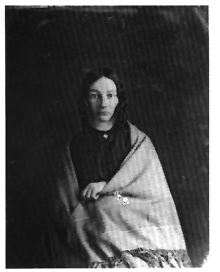
home
essays
 home essays |
Dan Meinwald

A memento mori is a form of image that urged a European person of the late Middle Ages to "remember thy death." To do this, a memento mori might represent death as a human skeleton--perhaps as the Grim Reaper gathering his harvest--or it might depict human bodies in an advanced state of decay.1 Its purpose is to remind the viewer that death is an unavoidable part of life, something to be prepared for at all times. Memento mori images are graphic demonstrations of the fact that death was not only a more frequent, but a far more familiar occurrence in medieval Europe than it is today. They express a concept of death that is characteristic of a specific time and place. The subject of this essay is an imagery of death characteristic of another time and place: nineteenth century America. Although the nineteenth century is much closer to our own era, these photographs and other images represent a concept of death that is in many ways as different from ours as that of the Europe of the Middle Ages.
The British sociologist Geoffrey Gorer makes some interesting observations on the difference between cultural attitudes toward death in the Victorian era and our own. In his 1955 article, "The Pornography of Death,"2 Gorer points out that death is treated in twentieth century society much like sex was treated in the nineteenth century. The subject is avoided, especially with children, or spoken of in euphemisms if it cannot be avoided. Death now, like sex then, is hidden, an event which takes place behind closed doors. The opposite is also true: in the nineteenth century, death was discussed as freely and openly as sex is today. If, as Freud has postulated, society is founded upon--and defined by--its repressions, our society has undergone a psychological about-face since the nineteenth century.3
Toward the end of his life, Freud came to view the human psyche as a battleground between the fundamental and irreconcilable urges of sexuality and death--or, as he expressed it, between the life-enhancing drives of the pleasure principle and the destructive drives of the death instinct.4 While Freud's postulation of a death instinct has never received full acceptance, even among his most faithful followers 5--and he himself described the theory as "metapsychological" (that is, not proven by clinical observation), and even as "far-fetched speculation"--it is nevertheless possible to view the history of Western attitudes toward death within the framework of this binary opposition.
This has in fact been done by the social historian Philippe Aries. According to Aries, the realms of sex and death were separated in Western culture until the end of the Middle Ages, largely due to the strictures of Christianity. With the loosening of these strictures, and the simultaneous emergence of individual consciousness, the two realms began to be associated. Centuries later, they combined in a macabre eroticism, of which an abundance of death-related imagery is tangible evidence. The outward treatment of death, in funerals and other rituals, remained unchanged or evolved discreetly, but love and death merged in the realm of the unconscious. Artists, and society as a whole, began to discover hitherto unrecognized resemblances between the two.
According to Aries, society erected a system of defenses--among them religion, morality, government, law, even technology--against the uncontrollable forces of nature, but these defenses were not impregnable: "This bulwark erected against nature had two weak spots, love and death, through which a little of the savage violence always leaked."6 Society restrained sexuality and death by means of taboos and ritualization, all of which subjected the individual to the control of the collective. Nevertheless, individuality proved stronger than the social forces that sought to control it.
Before the Middle Ages, death was part of the universal order. The body was returned to the earth, with no attempt made to commemorate, or even to locate the site. Only with the break from collective life did burial traditions change--as individuality emerged in life, so did it emerge in death. The transition was not immediate; in fact it took place over centuries. Individuality, in death and in life, emerged first in the upper strata of society, and only over time in the lower. It is only in the twentieth century that nearly every member of Western society has attained a personal burial space.
Individuality emerged after death as well. The concept of an immortal soul, which up to that point had largely been restricted to scholastic churchmen, came to gain almost universal acceptance because it represented a refusal to let identity dissolve into biological or social anonymity. That death was nevertheless a rude separation from life is demonstrated by the gruesomeness of the memento mori that also emerged during this era. According to Aries, however, the frightfulness of these images was not merely a means by which religion maintained its hold on the populace, as interpreters have often claimed. Instead of signifying fear of death, they express a passionate love of life, and a painful awareness that it must inevitably be renounced. They also demonstrate the conjunction of sexuality and death: death, always a man, even when a skeleton, is frequently shown as the sexual assailant of a young woman. By the eighteenth century, the separation of death from life gave it the same fascination, and the same opportunity for fantasy, that had long been given to eroticism.

By the nineteenth century, most of these factors had become considerably intensified. The containment of nature, far from being abandoned, had reached unimaginable heights in the domains of science and technology. Enlightened rationalism had also achieved enormous successes in the social sphere. By mid-century, even the consolation provided by religion seemed to have been stripped away by Darwin, though not without considerable resistance. The triumph of reason was nevertheless incomplete. Forces opposing these developments--those of irrationality and passion, sentiment and emotion--intensified as well. If sexuality could not be given undisguised expression, at least in polite society, it had covert expression in art, (and overt expression in pornography.7 It was possible, however, to treat death without restraint. The subject was given its most extreme forms of expression in the Romantic movements of painting, sculpture, poetry, and drama that began in the late eighteenth century, but it had more mundane outlets in everyday life.
In the United States, the pace of change was far more extreme than it had been in Europe. Eighteenth century America was still a traditional, communal, and rural world. The population of post-Revolutionary America was approximately two-and-a-half-million, and even the largest cities--Boston, New York, Philadelphia--were small towns. By the middle of the nineteenth century, the population had doubled and redoubled four times, and urban population exceeded rural by five to one.
In the closely-knit social groups of the eighteenth century, the death of each person affected the life of every other. Death, like life, was a communal affair. By the nineteenth century, this was no longer the case. Feelings which had previously been diffused within the community were now concentrated within the immediate family.8 With this concentration of emotion came an unprecedented intensity and tenacity of family feeling. In these circumstances, death had new meaning. The decease of a family member was a barely tolerable event, the cause of an emotional dilemma. The grief of the survivors took novel and acute forms, both in public and in private. Outward manifestations of grief, like funeral and burial customs, reflected inward transformations. Other manifestations included a new imagery of death, both visual and literary.

The melancholy disposition of the era is reflected in two extremely popular literary works, one from the beginning of the nineteenth century, the other from the middle. The first is from the poem Thanatopsis by William Cullen Bryant, published in 1817, and the progenitor for countless later examples of gloomy verse:
... All that tread The globe are but a handful to the tribes That slumber in its bosom.--Take the wings Of morning--and the Barcan desert pierce, Or lose thyself in the continuous woods Where rolls the Oregan, and hears no sound, Save his own dashings--yet--the dead are there; And millions in those solitudes, since first The flight of years began, have laid them down In their last sleep--the dead reign there alone. So shalt thou rest--and what if thou withdraw Unheeded by the living--and no friend Take note of thy departure? All that breathe Will share thy destiny....9Bryant's poem preserves a memory of the old model of human community, though one which exists in the afterworld rather than on earth. In contrast, the death of little Eva in Uncle Tom's Cabin, published in 1852, is a rupture that cannot be overcome:
The child lay panting on her pillows, as one exhausted,--the large clear eyes rolled up and fixed. Ah, what said those eyes, that spoke so much of heaven? Earth was past, and earthly pain; but so solemn, so mysterious, was the triumphant brightness of that face, that it checked even the sobs of sorrow. They pressed around her, in breathless silence."Eva," said St. Clare, gently.
She did not hear.
"O, Eva, tell us what you see? What is it?" said her father.
A bright, a glorious smile passed over her face, and she said, brokenly,--"O, love,--joy,--peace!" gave one sigh, and passed from death unto life!
"Farewell, beloved child! the bright, eternal doors have closed after thee; we shall see thy sweet face no more. O, woe for them who watched thy entrance into heaven, when they shall wake and find only the cold gray sky of daily life, and thou gone forever!"10
The visual imagery of death created in the nineteenth century represents a diversity of attempts to come to terms with this kind of disruption and discontinuity. These images are sometimes the secondary products of social practices like funerals and burials. In other cases, they are primary expressions of the grief process. In all instances, they reflect an impulse unique to the era in which they were made. This impulse can be described as a romantic and sentimental desire to surmount the fact of separation. In the twentieth century, the prevailing method of dealing with permanent separation is to put it out of mind.11 In the nineteenth century, the tendency was to keep it in mind, to retain the presence of the deceased person in any way possible. Visual images, especially photographs, provided some of the most effective and emotionally satisfying means of doing so.